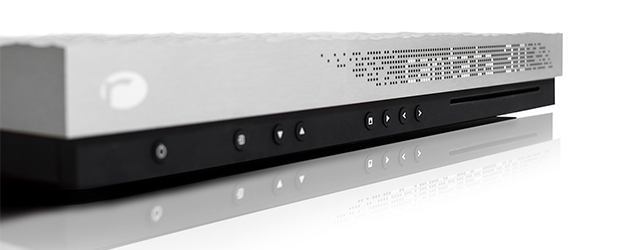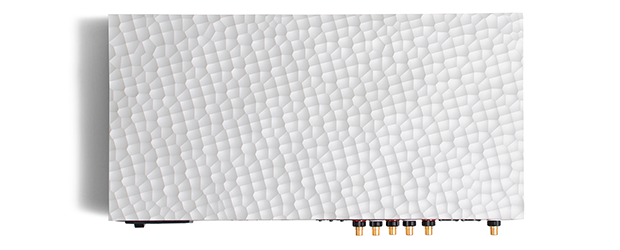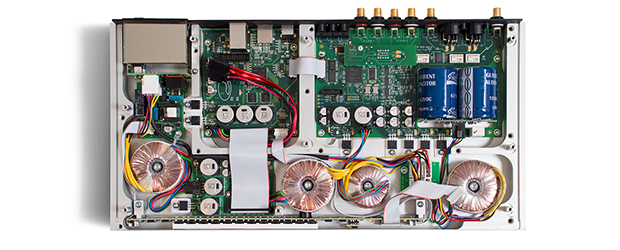The Latest and Greatest
Read Cantata 3.0 Listener Comments
This exciting and much anticipated upgrade of our Music Center provides an entirely new DAC board design, along with a new rear panel to accommodate new connectivity options. This upgrade represents our latest design thinking and advanced circuit execution techniques. Proudly built in the USA as always!
Sonic Performance: The degree to which we have improved sonic performance has even surprised us. The ability of the 3.0 version to unravel complex music and draw you into the music with greater excitement and musical understanding is really special. We have achieved truly significant improvements in resolution, spatial recreation, musical detail, dynamic contrast, bass weight, and flat out musical involvement, all while maintaining the basic character that the Cantata products have always provided. The improvements could not possibly be described as subtle
Expanded Flexibility: We have reconfigured the Music Center connectivity with three optical digital inputs plus two sets of configurable “flex” inputs, which are currently set up as two stereo analog line-level inputs. With this new flexibility combined with the built-in CD transport, Audio Class 2.0 USB, and UPnP network audio capability, the Cantata Music Center 3.0 serves as the hub of any high-end system.
Technical Details: We are utilizing a new DAC topology based on an R-2R ladder DAC that is typically used for medical imaging and aerospace designs where extreme bit accuracy is required. These DAC were not intended for audio use and hence require significant care and feeding to maximize performance. We have a incorporated minimum-phase digital filter in an advanced FPGA-based which is field-updatable. The analog section was meticulously tuned by a combination of measurement and listening across a broad range of music genres. The power supply received special attention, getting higher voltage rails and our special T-Network capacitors. Grounding and pcb layout are more important than ever to achieve the sonic potential of this groundbreaking approach.
In addition to the supplied full function remote control, the Cantata Music Center and C50 integrated amplifier are controllable from and iPad, iPhone or iPod Touch via the free Cantata App.
Other digital sources such as a DVD player can be played through the external inputs.
Based on the award-winning Opus 21 series, the Cantata design has been further refined and optimized for the emergence of computer-based music libraries. Built for simple integration into popular sources, the Cantata’s modular architecture will accommodate tomorrow’s formats and beyond.
Music Center 3.0 now available with DSD capability
Features:
– Firmware update provides DSD1 (64x) decoding using DoP via USB and S/PDIF inputs.
– No drivers required for any host which supports DoP.
– Firmware available for immediate download.
– DSD2 (128x) support via USB available with minor hardware upgrade. Contact us for pricing and availability.
Technical approach:
Toslink inputs are rated to 192kHz and support DSD1, but require a very high quality source and cable. Coax is more stable for DSD and requires Flex4 (optional input module which gives two coax digital inputs and one pair of line level inputs). DSD is converted to PCM within the Cantata FPGA using custom filtering, allowing us to make use of our extremely musical PCM DACs’ (as opposed to using a DSD DAC chip). This method was selected entirely to provide the very best performance for PCM audio and DSD playback. Down-conversion is to 88.2 kHz / 32-bit internally.
Sample Configurations
There are a number of ways in which the Cantata Music Center can connect with a source computer for playback of a digital library. Below are just a few sample configurations.
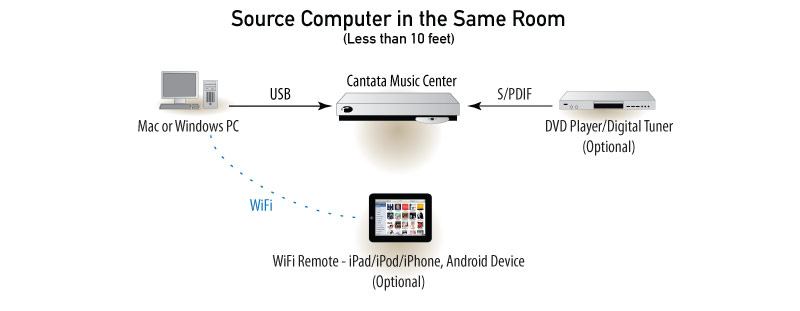
In this configuration, the host computer is connected directly to the Cantata Music Center over a USB cable. Playback on the source computer can be controlled via the mouse and keyboard, or through any WiFi-based remote control such as an Apple iPad. Note that a secondary input can also be used (in this case, a DVD player) and chosen with the supplied remote control or through the Cantata App with and iPad.

Because a USB cable is limited to a length of 15 feet, a USB cable connection may not be practical even if the source computer is in the same room.
To overcome this limitation, the Resolution Audio “Pont Neuf” Bridge effectively extends the USB port of the source computer by transmitting USB audio data asynchronously over an Ethernet or wireless connection to the Music Center. It requires no additional software drivers and is compatible with all music playback software and audio formats.
Due to the nature of ethernet connections, this approach also affords sonic improvements over a direct USB connection.
As with previous configurations, any WiFi-based remote control (such as an Apple iPad running the Apple “Remote” app) can control playback on the source computer.

Here, the source computer is in a different room and the Resolution Audio “Pont Neuf” is extending the USB connection over a wired ethernet connection through the home network. Likewise, the Cantata Music Center is connected to the home network through an Ethernet cable. All of the convenience and sonic benefits of an asynchronous USB connection are retained over much greater distances.
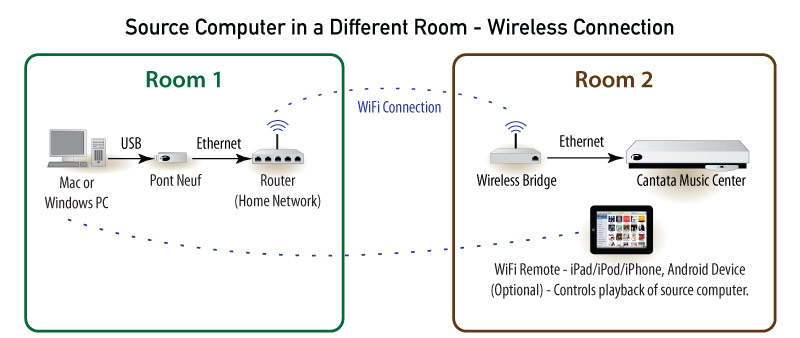
If a wired (Ethernet) connection isn’t practical, a “wireless bridge” can be added to allow the network information to travel wirelessly to the listening room.
FEATURES AND SPECIFICATIONS
- Dimensions:
43 x 22 x 5 cm (net) / 54 x 33 x 22 cm (shipping) - Weight:
5 kg (net) / 11.5 kg (shipping) - Power Requirements:
Preconfigured at factory 100-120 / 200-240 VAC, 50-60 Hz - Power Consumption:
35 Watts maximum active mode, < 1 Watt standby mode - Digital Inputs:
(3) Toslink, 192 kHz/24-bit maximum
USB 2.0: Asynchronous mode, 24-bit, 44.1/48/88.2/96/176.4/192 kHz
Ethernet:100-BaseTX, 10/100 Mbit/s, full-duplex - Flex Inputs:
2 pair, RCA. Standard configuration: line-level analog input - Outputs:
1 pair XLR (Balanced), 1 pair RCA (single ended). Both outputs can be used simultaneously. - Output Voltage:
Output Impedance: variable, 5.5 V rms maximum balanced, 2.5 V rms maximum single-ended 100 Ohms - Analog Attenuation:
0.5 dB steps from -30 dB to maximum 1.0 dB steps from -70 dB to -31 dB

